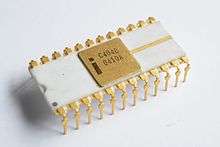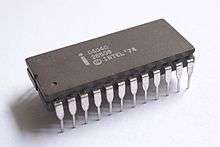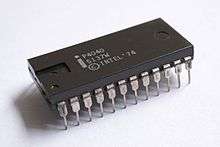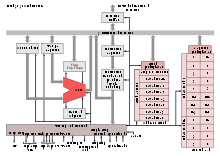Intel 4040
 The ceramic C4040 variant. | |
| Produced | From 1974 to 1981[1] |
|---|---|
| Common manufacturer(s) |
|
| Max. CPU clock rate | 500 kHz to 740 kHz |
| Min. feature size | 10μm |
| Instruction set | 4-bit BCD oriented |
| Predecessor |
Intel 4004 Intel 8008 |
| Successor | Intel 8080 |
| Package(s) |
|
The Intel 4040 microprocessor was the successor to the Intel 4004. It was introduced in 1974. The 4040 employed a 10 μm silicon gate enhancement load PMOS technology, was made up of 3,000 transistors[2] and could execute approximately 60,000 instructions per second.
 The ceramic D4040 variant. |
 The plastic P4040 variant. |
New features

i4040 microarchitecture.
- Interrupt
- Single Step
Extensions
| Intel 4040 registers | ||||||||||||||||||||||||||||||||||||||||||||||||||||||||||||||||||||||||||||||||||||||||||||||||||||||||||||||||||||||||||||||||||||||||||||||||||||||||||||||||||||||||||||||||||||||||||||||||||||||||||||||||||||||||||||||||||||||||||||||||||||||||||||||||||||||||||||||||||||||||||||||||||||||||||||||||||||||||||||||||||||||||||||||||||||||||||||||||||||||||||||||||||||||||||||||||||||||||
| ||||||||||||||||||||||||||||||||||||||||||||||||||||||||||||||||||||||||||||||||||||||||||||||||||||||||||||||||||||||||||||||||||||||||||||||||||||||||||||||||||||||||||||||||||||||||||||||||||||||||||||||||||||||||||||||||||||||||||||||||||||||||||||||||||||||||||||||||||||||||||||||||||||||||||||||||||||||||||||||||||||||||||||||||||||||||||||||||||||||||||||||||||||||||||||||||||||||||
- Instruction Set expanded to 60 instructions
- Program memory expanded to 8 KB (13-bit address space)
- Registers expanded to 24
- Subroutine stack expanded to 7 levels deep
Data Bus: 4-bit
Address Bus: 12-bit
Voltage: +15V
Designers
Federico Faggin proposed the project, formulated the architecture and led the design. The detailed design was done by Tom Innes (Tinnes of Bristol).
New support chips
- 4201 – Clock Generator 500 to 740 kHz using 4 to 5.185 MHz crystals
- 4308 – 1 KB ROM
- 4207 – General Purpose byte Output port
- 4209 – General Purpose byte Input port
- 4211 – General Purpose byte I/O port
- 4289 – Standard Memory Interface (replaces 4008/4009)
- 4702 – 256 byte UVEPROM
- 4316 – 2 KB ROM
- 4101 – 256 4-bit word RAM
Production
References
This article is issued from Wikipedia - version of the 6/16/2016. The text is available under the Creative Commons Attribution/Share Alike but additional terms may apply for the media files.